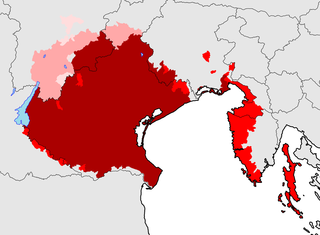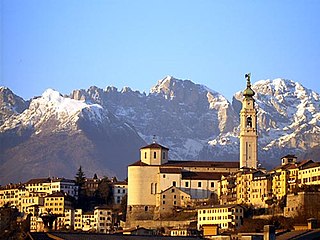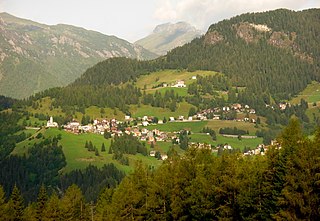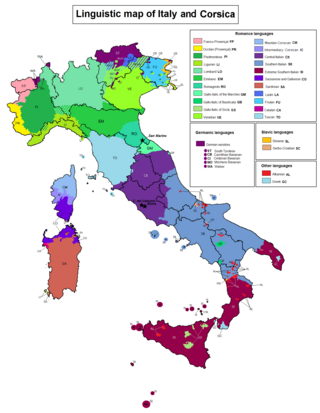
Ladin is a Romance language of the Rhaeto-Romance subgroup, mainly spoken in the Dolomite Mountains in Northern Italy in the provinces of South Tyrol, Trentino, and Belluno, by the Ladin people. It exhibits similarities to Romansh, spoken in Switzerland, as well as Friulian, spoken in north-east Italy.

Rhaeto-Romance, Rheto-Romance, or Rhaetian, is a purported subfamily of the Romance languages that is spoken in south-eastern Switzerland and north-eastern Italy. The name "Rhaeto-Romance" refers to the former Roman province of Raetia. The question of whether these languages actually form a subfamily is called the Questione Ladina. The Italian linguist Graziadio Ascoli, writing in 1873, found them to share a number of intricacies and believed they formed a linguistic group. The Rhaeto-Romance language differ from Italian in their evolution from Latin by having passed through a stage with phonemic vowel length, undergone certain consonant developments, and possibly developed a pair of central rounded vowels. If the subfamily is genuine, three languages would belong to it: Romansh in Switzerland, and Ladin and Friulian in Italy. Their combined number of speakers is about 660,000; the large majority of these speak Friulian.

Venetian, wider Venetian or Venetan is a Romance language spoken natively in the northeast of Italy, mostly in the Veneto region, where most of the five million inhabitants can understand it. It is sometimes spoken and often well understood outside Veneto: in Trentino, Friuli, the Julian March, Istria, and some towns of Slovenia and Dalmatia (Croatia) by a surviving autochthonous Venetian population, and Brazil, Argentina, Australia, Canada, the United States, the United Kingdom, and Mexico by Venetians in the diaspora.
Mario Alinei was an Italian linguist and professor emeritus at the University of Utrecht, where he taught from 1959 to 1987. He was founder and editor of Quaderni di semantica, a journal of theoretical and applied semantics. Until 1997, he was president of Atlas Linguarum Europae at UNESCO.

Belluno is a town and province in the Veneto region of northern Italy. Located about 100 kilometres north of Venice, Belluno is the capital of the province of Belluno and the most important city in the Eastern Dolomites region. With its roughly 36,000 inhabitants, it is the largest populated area of Valbelluna. It is one of the 15 municipalities of the Dolomiti Bellunesi National Park.

The languages of Italy include Italian, which serves as the country's national language, in its standard and regional forms, as well as numerous local and regional languages, most of which, like Italian, belong to the broader Romance group. The majority of languages often labeled as regional are distributed in a continuum across the regions' administrative boundaries, with speakers from one locale within a single region being typically aware of the features distinguishing their own variety from one of the other places nearby.

The Gallo-Italic, Gallo-Italian, Gallo-Cisalpine or simply Cisalpine languages constitute the majority of the Romance languages of northern Italy: Piedmontese, Lombard, Emilian, Ligurian, and Romagnol. In central Italy they are spoken in the northern Marches ; in southern Italy in some language islands in Basilicata and Sicily.
The primary languages of Calabria are the Italian language as well as regional varieties of Extreme Southern Italian and Neapolitan languages, all collectively known as Calabrian. In addition, there are speakers of the Arbëresh variety of Albanian, as well as Calabrian Greek speakers and pockets of Occitan.

Comelico is a mountainous region of northeast Italy, close to the Austrian border.

Cadore is a historical region in the Italian region of Veneto, in the northernmost part of the province of Belluno bordering on Austria, the Trentino-Alto Adige/Südtirol and Friuli-Venezia Giulia. It is watered by the Piave River which has its source in the Carnic Alps. Once an undeveloped and poor district, the former contado (countship) of Cadore now has a thriving economy based on tourism and a small manufacturing industry, specialising in the production of glasses.

Colle Santa Lucia is a comune (municipality) in the Province of Belluno in the Italian region of Veneto, located about 120 kilometres (75 mi) north of Venice and about 40 kilometres (25 mi) northwest of Belluno. As of 31 December 2004, it had a population of 408 and an area of 15.3 square kilometres (5.9 sq mi). The population speaks a Venetian dialect called Ladin Venetian that is heavily influenced by the Ladin language.
San Nicolò di Comelico is a comune (municipality) in the province of Belluno in the Italian region of Veneto, located about 130 kilometres (81 mi) north of Venice.

Selva di Cadore is a comune (municipality) in the province of Belluno in the Italian region of Veneto, located about 120 kilometres (75 mi) north of Venice and about 40 kilometres (25 mi) northwest of Belluno. As of 31 December 2004, it had a population of 557 and an area of 33.1 square kilometres (12.8 sq mi). The population speaks a Venetian dialect called Ladin Venetian that is heavily influenced by the Ladin language.

Vigo di Cadore is a comune (municipality) in the province of Belluno in the Italian region of Veneto, located about 120 kilometres (75 mi) north of Venice and about 45 kilometres (28 mi) northeast of Belluno.

Gallo-Italic of Sicily is a group of Gallo-Italic languages found in about 15 isolated communities of central eastern Sicily. Forming a language island in the otherwise Sicilian language area, it dates back to migrations from northern Italy during the reign of Norman Roger I of Sicily and his successors.

The Ladins are an ethnic group in northern Italy. They are distributed in several valleys, collectively known as Ladinia. These include the valleys of Badia and Gherdëina in South Tyrol, of Fassa in the Trentino, and Livinallongo and Ampezzo in the Province of Belluno. Their native language is Ladin, a Rhaeto-Romance language related to the Swiss Romansh and Friulian languages. They are part of Tyrol, with which they share culture, history, traditions, environment, and architecture.

The Questione Ladina is a controversy over whether the Romance languages of Romansh, Ladin and Friulian form a proper language subfamily or should rather be regarded as a part of a wider Northern Italian dialect continuum. Both the idea of a distinctive language sub-family and the denial of a Ladin unity still have strong proponents, the former especially among Swiss, German and Austrian, the latter among Italian linguists. The issue has, beyond the linguistic controversy, political implications being the areas involved subjected to territorial disputes, especially during the first half of the 20th century.
Bellunese Institution to study and preserve the Ladin culture in 35 municipalities of Agordino, Cadore, Comelico and Zoldo.
Fiorenzo Toso was an Italian academic, linguist, and dialectologist.

The Arianese dialect, typical of the territorial area of Ariano Irpino, is a vernacular variety of the Irpinian dialect, belonging in turn to the Neapolitan group of southern Italian dialects. Like all Romance languages, it descends directly from Vulgar Latin, a language of Indo-European stock that has been widespread in the area since Roman times.














